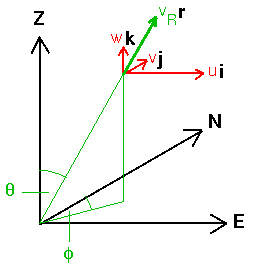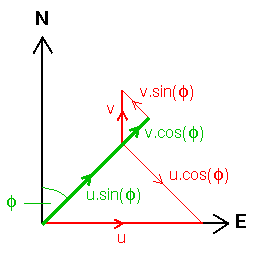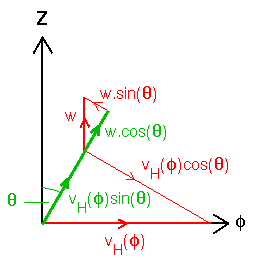|
|

 HOME ANNOUNCEMENTS CONTACTS DATA INSTRUMENTS MAIN MENU MISCELLANEOUS PLOTS PUBLICATIONS SCIENCE WIND-PROFILER PRINCIPLES For this page: INTERNAL LINKS |
THE NERC MST RADAR FACILITY AT ABERYSTWYTH WIND VECTOR DETERMINATION BY THE DOPPLER BEAM
SWINGING TECHNIQUE
|
|||
|
|
||||
|
|

|
|
In the diagram to the left, i, j, k and r
represent unit vectors in the East, North, vertical and radial
directions, respectively. For a wind-profiler radar beam directed at a
zenith angle of θ and at an azimuth
angle of φ, the radial component of the
wind vector, vR, i.e. that along
the beam pointing direction, is related to the zonal, u (i.e. towards East), meriodonal, v (i.e. towards North), and vertical, w, components through the following
expression:
In order to determine the full three dimensional wind vector, observations must be made in a minimum of 3 non-coplanar beam directions. |
|

|
A typical sequence includes observations made in the vertical direction and at an off-vertical angle (of around 17° for boundary-layer wind-profilers, or at 6° in the case of the NERC MST Radar) in two orthogonal azimuths; this is known as the Doppler Beam Swinging (DBS) technique. Since the the azimuths of the off-vertical beams are not, in general, aligned with the cardinal directions, it is useful to consider the problem in the frame of reference of a vertical plane along φ; the component of the horizontal wind vector in this plane, vH(φ), is given by: 
|
|||

|
The equation for the radial component of velocity simplifies to: 
In the case of boundary-layer wind-profilers, which typically make observations in only three beam pointing directions, the vertical velocity is determined from the Doppler shift of the vertically directed beam, and the horizontal component, in each azimuth, is determined through the relationship 
|
|||
|
The NERC MST Radar typically makes observations at in the vertical direction and at 6° off-vertical in four different azimuths, each one separated by 90° from the next; this allows each component of velocity to be derived from three different combinations of the radial velocities. In addition to the combination described above for 3-beam observations, the radial velocities for off-vertical beams with opposite azimuths can either be added or subtracted to derive the vertical or horizontal components of velocity, respectively: 
|
||||
|
|
||||
|
Page maintained by
David Hooper Last updated 15th August 2002 | ||||